 For couples who have been trying to get pregnant for month or even years, an unexplained infertility diagnosis can seem like a double blow–both physically and psychologically. They may be wondering how they will ever conceive if their doctor can’t figure out the case of their infertility.
For couples who have been trying to get pregnant for month or even years, an unexplained infertility diagnosis can seem like a double blow–both physically and psychologically. They may be wondering how they will ever conceive if their doctor can’t figure out the case of their infertility.
Here are several important points about unexplained that should give couples peace of mind.
You’re not alone
Unexplained infertility affects approximately 15 percent of couples. It is defined as the lack of an identified cause for a couple’s inability to conceive after 12 months (or six months for women 35 and older), despite a thorough assessment.
The evaluation will include documentation of:
- tubal potency and a normal uterus
- adequate ovulation
- a normal semen analysis
However, unexplained infertility may reflect small effects from multiple factors. In other words, one or both partners may not have optimal fertility, but this does not show up negatively as part of the fertility workup.
The difference between subfertility and unexplained infertility
The term subfertility can be uesed interchangeably with unexplained infertility, though they are not necessarily the same. Generally, subfertility means that conception is possible, though maybe challenging to accomplish without assisted reproduction intervention. In general, couples without fertility issues only have a 20 percent chance of conceving each month; the percentage decreases drastically for those who are subfertile or who have unexplained infertility.
There are many treatment options
Though you may not receive an official diagnosis with unexplained infertility, it does not mean that unexplained infertility is untreatable. The prognosis for unexplained infertility is directly dependent on the female partner’s age.
Treatment options include Clomid combined with IUI. If that isn’t successful after three or four cycles, we generally recommend IVF. In fact, results from FASTT*, the fast track and standard treatment randomized clinical trial, showed that it made more sense financially and emotionally to refer patients with unexplained infertility to IVF after failed IUIs versus advising more IUIs with injectable hormone medications.
In addition, laparoscopy will be offered to patients with symptoms suggestive of endometriosis or pelvic adhesions.
IVF can be a diagnostic tool
Once a patient undergoes IVF, we might discover factors we didn’t know about previously, such as poor egg quality, embryo development or implantation. Having the ability to look at these variables under laboratory conditions can help us assess a reason for your infertility.
Having no diagnosis can be frustrating
Having no diagnosis is often stressful and very frustrating. People generally do better knowing that there is an identifiable reason for their difficultires, and that there is a solution. Unexplained infertility is associated with a lot of uncertainty and creates typically high stress and frustration, more so, of course, when treatment fails.
Optimize your fertility
In addition to standard courses of treatment, many patients feel better emotionally and physically when they take steps to live a healthier and more mindful lifestyle, which may also benefit their fertility. Eating nutritious foods and avoiding unhealthy snacks, exercising, taking yoga and incorporating mind/body techniques can help you feel more in contol of a situation that may seem uncontrollable.
As always, please feel free to contact us if you have any questions about this or another fertility topic.
* http://www.fertstert.org/article/S0015-0282(09)00866-8/abstract
** http://www.resolve.org/about-infertility/medical-conditions/why-unexplained-infertility-is-sometimes-explained-during-ivf.html?referrer=https://www.google.com/
